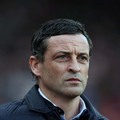This training session gives your players the opportunity to rehearse different kinds of defending, setting up situations where they are: defending individually in 1v1s; in pairs defending against a 3v2 overload; and defending as a unit against a 6v4 overload.
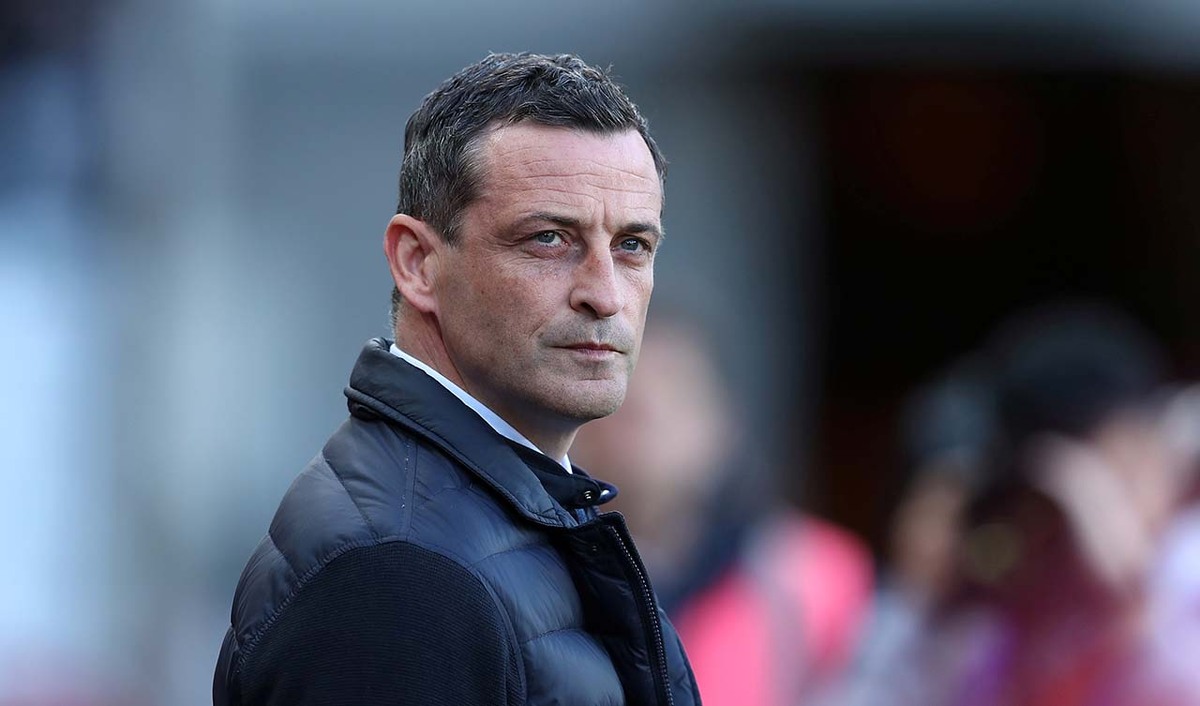
| Area | Up to 70x50 yards |
| Equipment | Balls, bibs, cones, 2 goals |
| No. of Players | 10 players + 2 goalkeepers |
| Session Time |
Defending 1v1: 10mins, Defending 3v2 overloads: 20mins, Forcing play wide: 20mins, Defending attacking waves: 8mins, Defending the box: 10mins, Back four defend the box: 10mins |
This training session gives your players the opportunity to rehearse different kinds of defending, setting up situations where they are: defending individually in 1v1s; in pairs defending against a 3v2 overload; and defending as a unit against a 6v4 overload.
It is a physically challenging session, particularly aimed at developing the most pensive of players.
While it is primarily a defending session, there is plenty in it to keep the attacking players engaged throughout, as the onus is on them to create chances and score goals. Given that the attackers have an overload advantage for much of the session, it should give them plenty of encouragement.
The physical nature of the session for the defenders means that mental and physical fatigue will become a factor and should influence decision making and defensive solidarity.
Common themes to coach throughout this training session are body shape to defend, aggression, communication, organisation, the desire to defend, the role of the goalkeeper within games, and maintaining the correct distances so the back four shifts as a unit and doesn’t leave gaps.
We could finish the session by taking the principles that we have worked on into an 11v11 game, with the focus on coaching the back four. The game could be adjusted to 11v10 to ensure that one team faces a defensive challenge.
DEFENDING 1v1
We set up an area of 45x30 yards with two goals at each end. The playing area is divided into zones: a 15x15-yard box is marked out in front of each goal and there is a 15x30-yard central zone between the end zones, as shown [1].
1
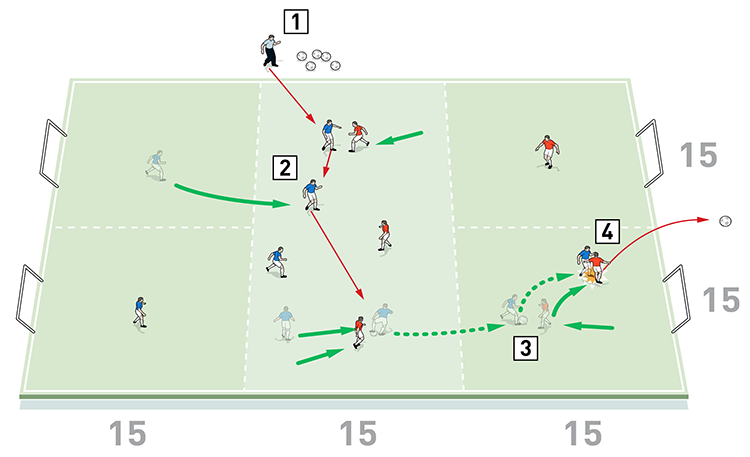
2. The team with the ball are joined in the central zone by one of their defenders, giving them a 4v3 overload
3. The possession team must create a chance for an attacker to go 1v1 with an opposition defender by dribbling into one of the end zones
4. Here the defender forces the attacker wide in a 1v1 and clears the ball
We’re using 10 outfield players divided into two teams of five. Each team has three players in the central zone and one player in each of the two boxes at the end it is defending.
The coach starts play by passing into the central zone. The possession team with the ball are joined in the central zone by one of their defenders, giving them a 4v3 overload. The object of the game is to get an attacker from the possession team into a position to dribble into one of the end zone boxes to go 1v1 with an opposition defender. The attacker must then try to score in the goal in that end zone.
Once the players become accustomed to the game, we can progress this activity by allowing the other defender to slide across into the box that the attacker has entered to make it 2v1 in favour of the defenders.
We play two games of four minutes each.
DEFENDING 3v2 OVERLOADS
We set up a playing area of 50x70 yards divided into two side-by-side areas of 50x35 yards. Each of the two areas has a goal at the top end, as shown [2].
2
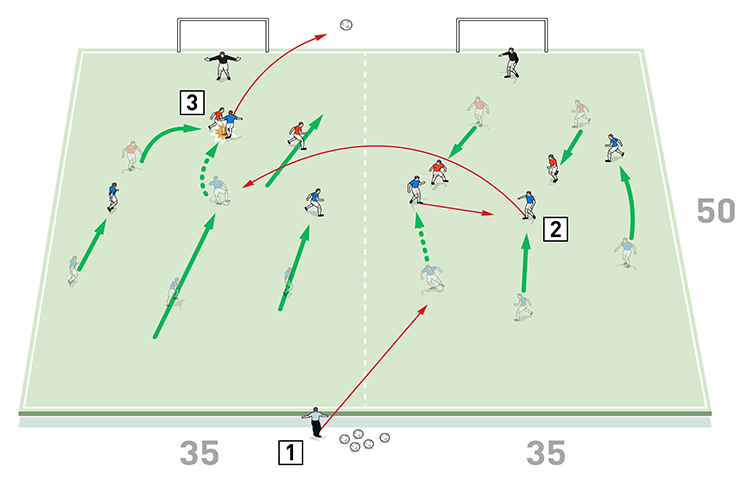
2. The attackers try to score in the goal in their area but the defenders make it hard, so they switch the play to the attackers in the other area
3. An attacker gets into space to receive the switch, but a red defender covers the move and clears the ball before the blues can exploit their 3v2 overload
We’re using 10 outfield players split into a defending team of four and an attacking team of six. It’s 3v2 in favour of the attacking team in each of the areas and play starts with the coach passing into the attackers on one side.
The attacking team must then try to score in the goal in their area, but if the defenders make it hard, the attackers can switch play to the attackers in the other area if they can see a player in space to receive.
We want to see the defenders focusing on handling the overload by showing attackers wide, using good communication and demonstrating a desire to defend.
We play four games of five minutes each. We can progress the activity by joining the two areas together and making the game 6v4 in favour of the attackers. This means the defenders have a decision to make: should they slide over to protect the goal under attack, or leave players in front of both goals to protect against the switch of play.
FORCING PLAY WIDE
We set up a playing area of 60x40 yards with a goal and a goalkeeper at each end. We’re using five outfield players split into a defending team of two and an attacking team of three.
Play starts and restarts from the attacking team’s goalkeeper. The attackers must try to turn their 3v2 overload into goal scoring chances. We want to see the defending pair respond by showing the attackers outside, with the player nearest the ball going to defend. The defenders must work together to force play wide and communicate well with their goalkeeper to keep organised and clear the resulting cross, as shown [3].
3
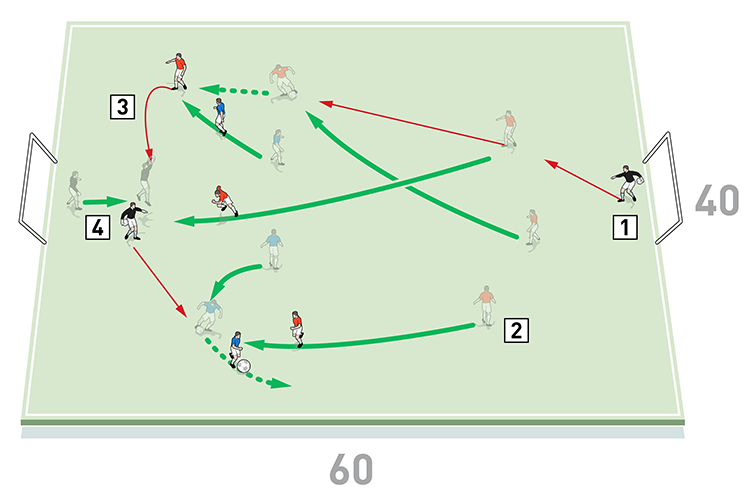
2. The attackers try to turn their 3v2 overload into goal scoring chances
3. The blue defenders try to force the attackers wide, with the player nearest the ball going to defend
4. The blue defenders work together and communicate with their keeper to keep organised and deal with the resulting cross. They then launch a counter-attack
If the defending team gains possession, they should counter-attack the opposition goal.
We play four games of five minutes each.
DEFENDING ATTACKING WAVES
We set up a playing area of 50x70 yards with two goals at the same end, as shown [4]. Both goals have a keeper and we are using 10 outfield players, split into an attacking team of six and a defending team of four.
4
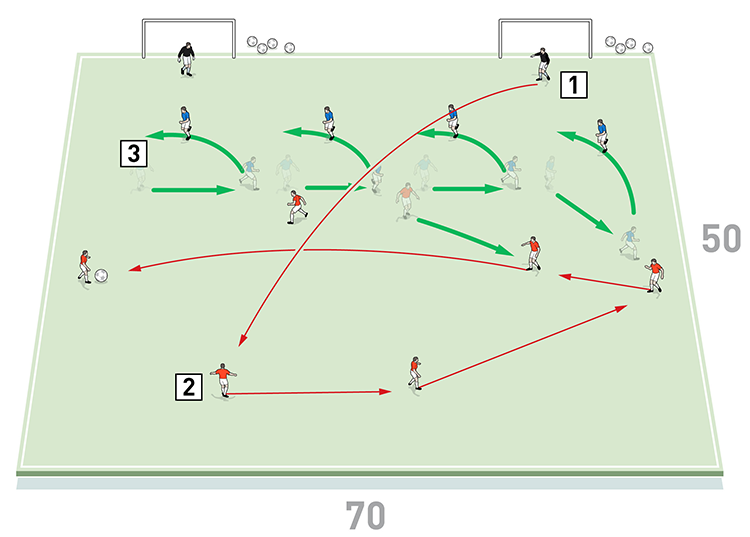
2. The attackers pass the ball to create a scoring opportunity. They can score in either of the goals
3. The back four should keep organised, moving across as a unit to react quickly to switches of play
Play starts and restarts with one of the keepers, who kicks the ball to the attacking team to receive and build an attack. The attackers can score in either of the goals. The defending back four should be encouraged to communicate with each other and keep well organised, moving across as a unit to react quickly to any switches of play.
We want to see the defenders keeping the correct distances between one another and they should demonstrate a high work rate to help them to combat the overload.
We play four games of two minutes each.
DEFENDING THE BOX
We set up a playing area in the final third of the pitch, with a goal and a goalkeeper at one end. We are using eight outfield players, split into an attacking team of six and a defending team of two, with a pair of attackers and a wide defender on each side of the penalty area and two central attackers in the centre.
In the first attack, the first wide left attacker goes 1v1 against the defender to try to cross the ball into the central attacker, who finishes on goal, as shown [5a].
5a
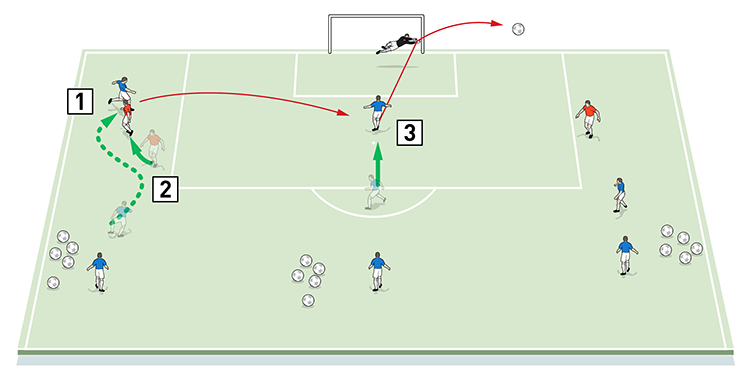
2. The red defender attempts to block the cross
3. The central attacker meets the cross and takes a shot at goal
After the first attack is dead, the second wide left attacker makes a run at goal against the same defender and tries to score with a shot, as shown [5b].
5b
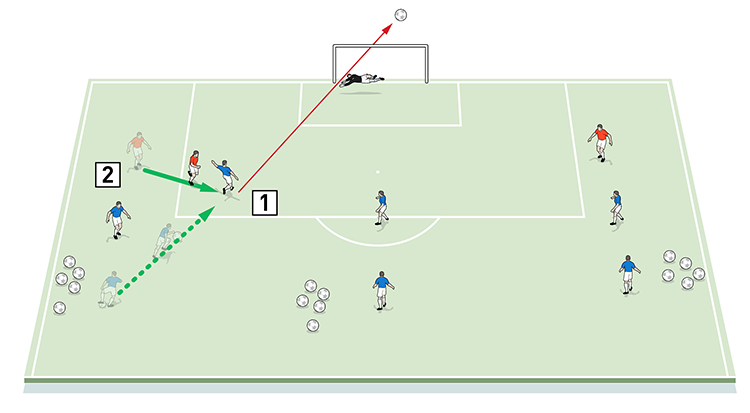
2. The red defender must make firm contact and try to block the shot
After the second attack is dead, the two central attackers play a bounce pass with each other and one attempts a shot at the goal. The same wide defender must be alert to come across and cover the attack and should try to block the shot, as shown [5c].
5c
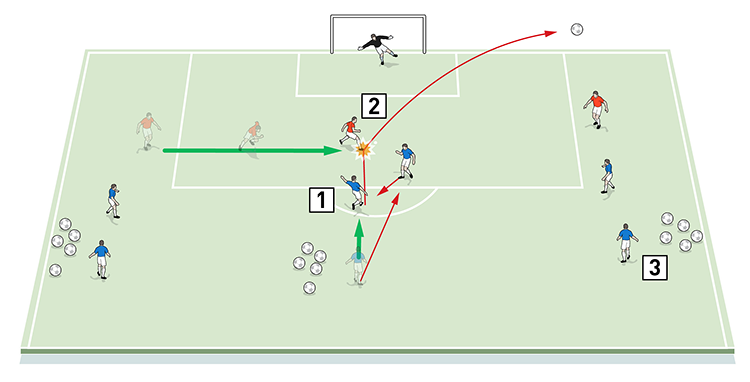
2. The same wide defender must be alert to cover the attack and succeeds in blocking the shot
3. Next, repeat the three attacks on the other side of the pitch
Repeat the three attacks on the other side of the pitch and then rotate attackers and defenders.
We want see the defenders focused on stopping crosses and blocking shots. In this drill, the body shape of the defenders is important and they should show aggression and try to make physical contact with the attackers.
BACK FOUR DEFEND THE BOX
We set up a playing area in the final third of the pitch, with a goal and a goalkeeper at one end. We are using ten outfield players, split into an attacking team of six and a defending team of four. The attackers are set up as a front two, with two attacking midfielders and two wide players, while the defenders set up as a back four, as shown [6].
6

2. The blue defenders should focus on working together as a back four, using good communication and aggression to prevent each attack
The coach feeds the attacking players with a succession of different balls for the opposing back four to try and clear. The attackers should create different kinds of attack: from wide areas, from central areas, from midfield, and they should also attempt aerial attacks.
The defenders should focus on working together as a back four, using good communication and forming triangles when one steps up to close down the ball. They should show aggressive play when defending against shots and crosses.
The players should reset after each attack is dead. We play for ten minutes.
Editor's Picks
Attacking transitions
Deep runs in the final third
Using the goalkeeper in build-up play
Intensive boxes drill with goals
Penetrating the final third
Creating and finishing
My philosophy
Pressing initiation
Compact team movement
Coaches' Testimonials

Alan Pardew

Arsène Wenger

Brendan Rodgers

Carlos Carvalhal

José Mourinho

Jürgen Klopp

Pep Guardiola

Roy Hodgson

Sir Alex Ferguson

Steven Gerrard
Coaches' Testimonials

Gerald Kearney, Downtown Las Vegas Soccer Club

Paul Butler, Florida, USA

Rick Shields, Springboro, USA

Tony Green, Pierrefonds Titans, Quebec, Canada
Join the world's leading coaches and managers and discover for yourself one of the best kept secrets in coaching. No other training tool on the planet is written or read by the calibre of names you’ll find in Elite Soccer.
In a recent survey 92% of subscribers said Elite Soccer makes them more confident, 89% said it makes them a more effective coach and 91% said it makes them more inspired.
Get Monthly Inspiration
All the latest techniques and approaches
Since 2010 Elite Soccer has given subscribers exclusive insight into the training ground practices of the world’s best coaches. Published in partnership with the League Managers Association we have unparalleled access to the leading lights in the English leagues, as well as a host of international managers.
Elite Soccer exclusively features sessions written by the coaches themselves. There are no observed sessions and no sessions “in the style of”, just first-hand advice delivered direct to you from the coach.

